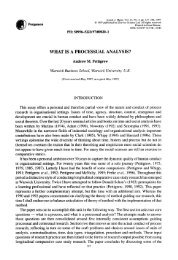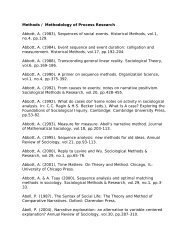Qualitative methods for analyzing process data How do we research ...
Qualitative methods for analyzing process data How do we research ...
Qualitative methods for analyzing process data How do we research ...
Create successful ePaper yourself
Turn your PDF publications into a flip-book with our unique Google optimized e-Paper software.
<strong>Qualitative</strong> <strong>methods</strong> <strong>for</strong><strong>analyzing</strong> <strong>process</strong> <strong>data</strong>Ann Langley, HEC MontréalAOM PDW, HonoluluSaturday August 6th 2005<strong>How</strong> <strong>do</strong> <strong>we</strong> <strong>research</strong><strong>process</strong>es?Simple ans<strong>we</strong>r: <strong>we</strong> go out and look• Observations in vivo(meetings; conversations; events; sha<strong>do</strong>wing; etc.)• Collecting memories and interpretations(interviews; diaries; focus groups; questionnaires)• Collecting temporally-embedded artifacts(minutes of meetings; plans; reports; etc.)Emphasis on qualitative <strong>data</strong>1
But then what?…Process <strong>data</strong> (after Mintzberg, 1979)Greatest challenge of <strong>process</strong><strong>research</strong>• "Making sense" of the <strong>data</strong>• while respecting the complexity ("accuracy")• as simply as possible ("parsimony")• with wide applicability ("generality")(Criteria <strong>for</strong> good theory suggested by Weick,1979)2
Seven strategies <strong>for</strong> theorizingfrom <strong>process</strong> <strong>data</strong>…1. Narrative strategy2. QuantificationKevin's presentation3. Alternate templates4. Grounded theory5. Visual mapping6. Temporal decomposition7. Comparative caseLangley, AMR, 1999Strategy 1: Narrative• Tell the story ("Just write it up…")• Examples: Chandler (history); Geertz(anthropology – "thick description")• Good narrative creates a sense of "déjà-vu"• Priority on accuracy above parsimony andgenerality• "To be determinate, <strong>we</strong> must be indeterminate"(Van Maanen, 1996)3
Laurel Richardson inHandbook of <strong>Qualitative</strong> Reseach• I have a confession to make. For 30years, I have yawned my way throughnumerous supposedly exemplaryqualitative studies… (…) [this is]qualitative <strong>research</strong>'s own dirty littlesecret. Our empire is (partially)unclothed.Narrative approach…Have <strong>we</strong> made any progress?4
My experience….• Description as a first step• Writing as a stimulus <strong>for</strong> theorizing• The construction of a "narrative"incorporating <strong>data</strong> and theory as a laststep:• possible only when one has identifiedthe plot (the theoretical angle)More exciting ways to usenarrative approaches• Investigating the narratives producedby organization members – narrative asa unit of analysis• Presenting narratives that draw ondifferent theoretical lenses (see strategy3….)• Literary approaches5
Example: Analyzing identitynarratives during mergers• Alberta / Quebec health care mergers• Narratives of different groups as they livethrough identity threats• Generating summary narratives by group• Identifying key components of narrative:• Change in context• Perceived identity threat• Coping mechanisms (ours, others)• Evolving identity patterns• Comparing narratives, identifying typicalsequences and their driversSeven strategies <strong>for</strong> theorizingfrom <strong>process</strong> <strong>data</strong>…1. Narrative strategy2. Quantification3. Alternate templates4. Grounded theory5. Visual mapping6. Temporal decomposition7. Comparative caseLangley, AMR, 19996
Strategy 3: Alternate templates• Fit different a priori theoretical framesto <strong>data</strong>• Classic example: Allison, 1971 TheEssence of Decision (Cuban MissileCrisis)• Accuracy, parsimony and generalitycreated through the cumulation ofperspectivesExample: Markus (1983)• Why <strong>do</strong> people resist in<strong>for</strong>mationsystems?• People theory: it’s a question of individuals’cognitive styles• Technological theory: people resistbecause systems are not user-friendly• Political theory: people resist because theyfear loss of po<strong>we</strong>r and control7
Alternate templates strategyCompleteness through complementary modelsParsimony by keeping them separate!My experience• Very attractive strategy <strong>for</strong> study of asingle case• Harder than it looks to keep templatesseparate• The problem of integrating the variousmodels…8
Seven strategies <strong>for</strong> theorizingfrom <strong>process</strong> <strong>data</strong>…1. Narrative strategy2. Quantification3. Alternate templates4. Grounded theory5. Visual mapping6. Temporal decomposition7. Comparative caseLangley, AMR, 1999Strategy 4: Grounded theory• Build theory bottom-up (no a priori frame)• Glaser & Strauss (1967); Corbin & Strauss(1990)• Exemplar paper:• Gioia, Thomas, Clark and Chittipeddi: Symbolismand strategic change in academia, OrganizationScience, 1994• ATLAS/ti or N'Vivo as modern coding tools• Stresses accuracy above parsimony andgenerality9
Doing a qualitative <strong>do</strong>ctoralthesis with ATLAS/ti (example)• P 2: InterviewJFH.txt - 2:2 (523:525) (Super)• Codes: [solitude]• I see my entourage as helpful because they didn't hurt. You are very alone in a <strong>process</strong>like that, people <strong>do</strong>n't know that and they <strong>do</strong>n't understand.• P 3: InterviewCL.txt - 3:2 (1154:1159) (Super)• Codes: [solitude]• I <strong>do</strong> qualitative work now. But I <strong>do</strong> it with a team of 7 or 8people with me. But what I did <strong>for</strong> my thesis was not like that. You're all alone. Doingqualitative <strong>research</strong> is very hard. Miles and Huberman – they <strong>we</strong>re in a team.• P 4: InterviewMEBB.txt - 4:3 (1145:1151) (Super)• Codes: [solitude]• And probably, that's when I came closest to dumpingeverything into the garbage. I felt really alone! OK, my colleague here helped a bit, but infact, you are all alone… you are all alone! The transition from the field to after the field wasvery very difficult.10
FromGioia etal.(detail)Grounded theory strategyDescription built up from the trees, not <strong>do</strong>wn from <strong>for</strong>est11
My experience• Requires patient and laborious micro-analysisbut potentially po<strong>we</strong>rful…• Software (ATLAS/ti, N'VIVO) helps, butincreases the temptation to overcode• Tends to produce a hierarchical andsomewhat similar theoretical frames• Code a bit to explore the <strong>data</strong> at first; getinsights; complete coding to verify afterwardsSeven strategies <strong>for</strong> theorizingfrom <strong>process</strong> <strong>data</strong>…1. Narrative strategy2. Quantification3. Alternate templates4. Grounded theory5. Visual mapping6. Temporal decomposition7. Comparative caseLangley, AMR, 199912
Strategy 5: Visual mapping• A picture is worth a thousand words (?)• Graphs, drawings, diagrams• Temporal flow charts• Relationships bet<strong>we</strong>en people• Tables and matrices• Methods gurus: Miles and Huberman• A favorite thinking tool13
Progression inleadershipteamsDenis et al.,2001, AMJMy experience• A parsimonious way to communicate alot of in<strong>for</strong>mation• …sometimes clearer <strong>for</strong> the creatorthan the reader!• Need to get beyond the surface"patterns" to understand explanatorymechanisms –otherwise it's just anotherkind of description14
Visual mapping strategy…A metaphor with limitations!Seven strategies <strong>for</strong> theorizingfrom <strong>process</strong> <strong>data</strong>…1. Narrative strategy2. Quantification3. Alternate templates4. Grounded theory5. Visual mapping6. Temporal decomposition7. Comparative caseLangley, AMR, 199915
Strategy 6: Temporaldecomposition• Decompose a <strong>process</strong> into "phases"• Continuous episodes separated by discontinuities• Phases may or may not have conceptualsignificance…• … but become units of analysis <strong>for</strong>comparison across time• Example: Barley (1986) "Technology as anoccasion <strong>for</strong> structuring," ASQ• …Another favoriteExample: Leadership andchange under ambiguityStartingpointPhase 1Phase 2Phase 3Phase 4Phase 5LeadershipteamcohesionSymbolicchangeSubstantivechangePoliticalchangecredibilityof leadersCEO 1MED 1CEO 2OP MGRMED 216
Iterative model of leadership andstrategic change under ambiguityPhase 1, 2, 3…Leadershipteam•Cohesion•Internal support•External supportTactics•Transparency•Internal vs.externalorientationEffects•Substantive•Symbolic•PoliticalDenis, Lamothe, Langley, AMJ, 2001Barley: Evolution of interactionsassociated with a<strong>do</strong>ption of CT scanner• Hospital 1: coding of conversations bet<strong>we</strong>enradiologists and technicians during examinations• Phase 1: mutual exploration• Unsought validation• Anticipatory questions• Preference stating• Phase 2: technician takeover• Clandestine teaching• Role reversal• Blaming the technologist17
Barley’s analysisTemporal decompositionstrategyNot all <strong>process</strong>es are easily decomposed18
My experience• A priori, single cases are risky withoutrepetitive elements!• Temporal decomposition allows theorizingfrom a single case• The "phase" becomes an element ofcomparison• This requires a context that can easily bedecomposed…• …and an iterative theoretical structureSeven strategies <strong>for</strong> theorizingfrom <strong>process</strong> <strong>data</strong>…1. Narrative strategy2. Quantification3. Alternate templates4. Grounded theory5. Visual mapping6. Temporal decomposition7. Comparative caseLangley, AMR, 199919
Strategy 7:Comparative case strategy• Identify <strong>process</strong> characteristicsassociated with extreme outcomes(success, failure)• Exemplar: Eisenhardt (AMJ, 1989):"Making fast decisions in high velocityenvironments" – 8 cases of decisions incomputer firms• Emphasis on parsimony and generalityComparative strategy"Success""Failure"<strong>How</strong> are the <strong>process</strong>es different?(Compress <strong>process</strong>es into variables)20
Table from Eisenhardt (1989)Eisenhardt’s model21
My experience• Po<strong>we</strong>rful approach• Not as easy as it looks…• Successes and failures are not alwaysso easily distinguised• Loss of temporal elements (produces avariance rather than a <strong>process</strong> model)Seven sense-making strategies incombinationGroundedTheoryNarrativeTemporalbracketingQuantificationAlternateTemplatesVisualMappingSyntheticstrategyGrounding strategies Organizing strategies Replicating strategies22
General observations: Sensemakingfrom <strong>process</strong> <strong>data</strong> (1)Type of understanding obtained varies withsense-making strategy…• Interpretations: "sense" of participants• Narrative strategy; grounded theory• Predictions: "sense" of causal laws• Comparative strategy; quantitative strategy• Patterns: "sense" of surface structure• Visual mapping• Mechanisms: "sense" of driving <strong>for</strong>ces• Narrative strategy, alternate templates, temporaldecompositionGeneral observations: Sensemakingwith <strong>process</strong> <strong>data</strong> (2)• PREPARE to COMPARE…• Compare with a priori theories• Alternate templates, quantification• Compare with cases or sub-cases chosen <strong>for</strong> theirdifferences/ similarities• Comparative, visual mapping strategies• Compare different time periods within cases• Temporal decomposition• Compare micro-incidents within a case• Grounded theory, narrative, quantification23
Barley 1990General observations: Sensemakingwith <strong>process</strong> <strong>data</strong> (3)Creative inspiration plays a key role• But creativity favours the prepared mindSo…• Collect good <strong>data</strong>• Analyse <strong>data</strong> from multiple angles• Build on prior "tacit" knowledgeAnd remember: Rigorous <strong>data</strong> analysis isneeded to verify emerging ideas24
Other useful notes onqualitative analysisRevie<strong>we</strong>r comments…… the problem of "credibility"• "I was troubled throughout themanuscript by the question of whetherto "believe" the account. I <strong>do</strong> believethe author, but the point is that the waythe results are presented leaves theauthor open to this criticism…."25
Issues of "credibility" duringqualitative <strong>data</strong> collection+Access tosituationsRapport withpeople+Proximity tophenomenon+Risk ofcontamination(effect ofthe <strong>research</strong>eron thephenomenon)To attenuate the risks• Multiple sources• Multiple <strong>research</strong>ers• Insider/ outsider / peer review• Make biases explicitRisk of"going native"(becomingsocialized tothe point ofnot seeingthings)Risk ofpoliticalalignment(loss ofneutrality)+-Qualityof <strong>data</strong>Issues of "credibility" during <strong>data</strong>analysis & interpretationRichnessand depth ofqualitative<strong>data</strong>+Saturation andauthenticity+Credibilityofinterpretation+Ambiguity ininterpretation-+-To attenuate the concernsExhaustive <strong>do</strong>cumentation of analysisMember check: validation with in<strong>for</strong>mantsMultiple <strong>research</strong>ers (<strong>do</strong>uble coding)Triangulate with quantitative <strong>data</strong>Field sites named?26
Different responses to the issue ofgeneralizability in qualitative <strong>research</strong>• Transferability: The important thing is to providesufficient in-depth contextual in<strong>for</strong>mation so that thereader can judge transferability to another situation• Accent on analytic generalizability (to theory) ratherthan empirical generalizability (to population). Eachcase provides a complete test of a theory (much likean experiment)• Replication on polar cases – if thesamephenomenonoccurs in very different situations, it is more likely tobe general• Generalizability is not relevant – qualitative <strong>research</strong>is interested in the particular, not the general27








